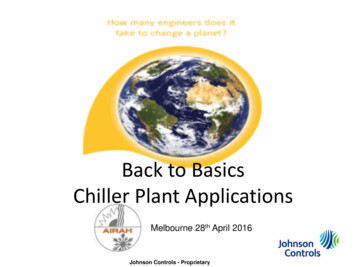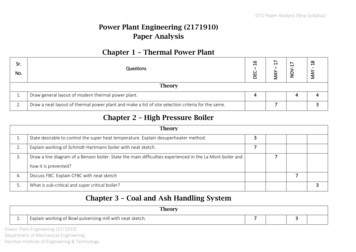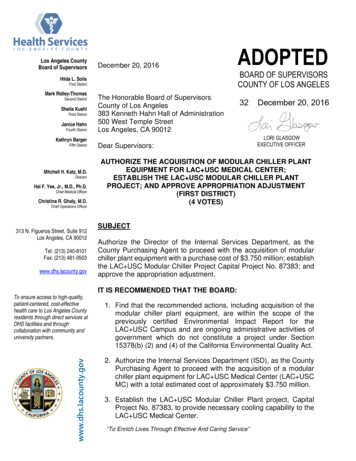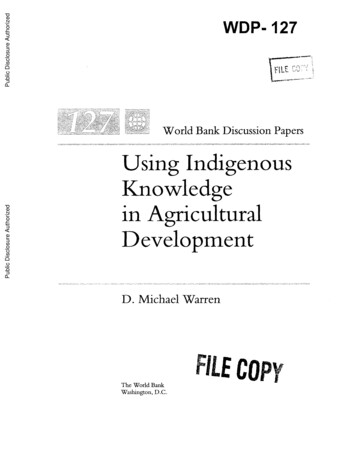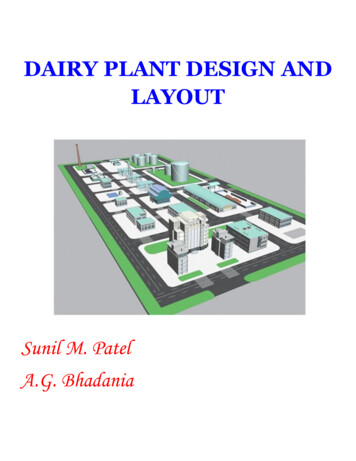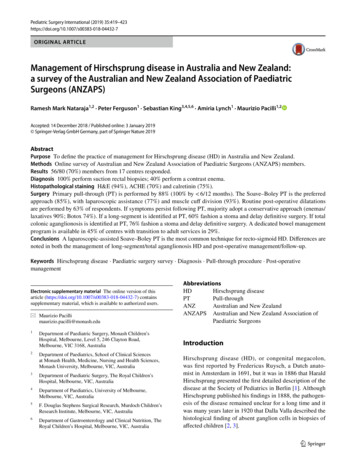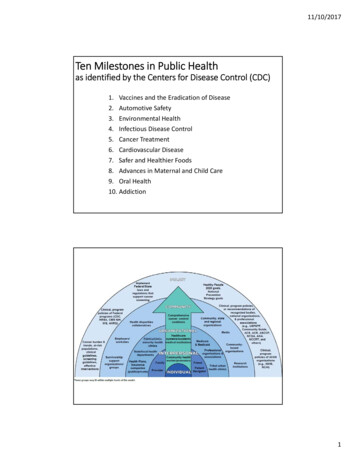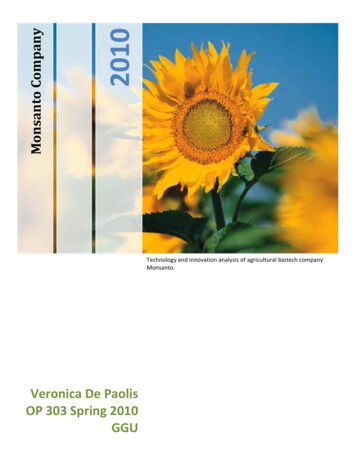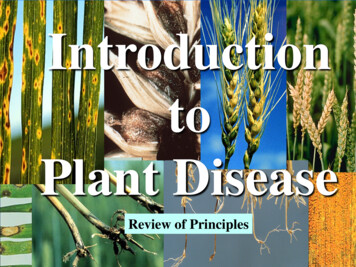
Transcription
IntroductiontoPlant DiseaseReview of Principles
What is a disease?Any abnormal condition that damages aplant and reduces its productivity orusefulness to man.Two types of diseases.1. Non-infectious (abiotic)» Not caused by a living parasitic organism;usually an environmental factor2. Infectious (biotic)» Caused by a living parasitic organism
What is a non-infectious disease?-- Diseases caused by someenvironmental factor that producesan abnormal plant, abnormalappearance.Examples: Nutrition. Excess or deficiency– N deficiency, yellowing Moisture. Deficient or excessivewater.– Deficiency, stunting– Excessive, lack of oxygen toroots.
What is a non-infectious disease?More examples: Temperature. Cold or hot.– Frost damage; heat sterility in smallgrains. Meteorological conditions.– Sun, sunscald.– Heat canker caused by hightemperature Toxic chemicals.– Ozone injury; Salt injury.
What is an infectious disease?Infectious (biotic) diseases arecaused by organisms that attackplants and get their nutrition fromthem. Host - the plant attacked by aparasite. Pathogen - the organism causing thedisease.– Fungi; Bacteria; Viruses;Mycoplasmas; Nematodes
Terms Parasite - an organism living on or inanother living organism and obtainingfood from another organism. Obligate parasite - always a parasite;can only live on or in another organism. Parasites causing leaf rust, stem rust ofcereals. Facultative parasite - having the abilityto be a parasite; can live on living ornon-living host. Parasites causing leaf spots of cereals.
Terms Symptoms - expressions of plantdiseases; visible abnormalities; tissuedeath; stunting; abnormal color– Necrotic - dead and discolored.– Chlorosis - yellowing of normallygreen tissue Signs - presence of pathogen or its parts– fungal structures; bacterial ooze
Terms Inoculum - pathogen or its partsthat can cause infection. Thatportion of the pathogen broughtinto contact with the host.– Spores; mycelial fragments orstructures Predispose - weaken plants;increase effects of infectiousdiseases.– Temperature, moisture, wind,light, soil pH, nutrition,herbicides
Three factors needed to produce a mentIf any of the 3 factors is missing disease will not develop.
Plant Disease TrianglePathogenVirulent pathogenFungi, Bacteria,Viruses,Nematodes,Mycoplasmas andSpiroplasmasHostSusceptibilityDiseaseFavorable EnvironmentAir temperatureSoil temperatureRainfallSoil moistureSoil fertilitySoil type and soil pHRelative humidityStand densityPlanting time
PathogenThe organism causing the disease. Fungus, fungi - organisms which lackchlorophyll and range in form from asingle cell to a body mass of branchedfilamentous hyphae. Includes theyeasts, molds, smuts, and mushrooms. Hyphae, mycelium, thread-likefilaments. Fruiting bodies, structures containingspores; can be signs on the host. Spores, reproductive unit; seeds; E.g. Rusts, smuts, leafspots, powderymildew
Pathogen Bacterium, bacteria - microscopicsingle-celled organisms;reproduction by division of bodyinto two parts.– Bacterial blights, wilts, fireblight Viruses - submicroscopic particles ofRNA with a protein coat; obligateparasite.– Wheat streak mosaic, cucumbermosaic, potato viruses
Pathogen Nematodes - generallymicroscopic eelworms orroundworms Usually not a serious problem inNorth Dakota Carriers or vectors of viruses,fungi, or bacteria. Mycoplasmas - microorganismswith no cell wall, no definiteshape. Aster yellows (purple top in potatoand tomato).
Environmental Factors Once disease established, localenvironment determines rate of diseasedevelopment– Disease severity can differ from site to site or be similarin region Rainfall– Risk of disease greatest with highest rainfall levels– Dry conditions or intermittent wet/dry can limit diseasedevelopment Temperature can influence disease
Plant Disease TriangleA host, pathogen, and favorable environment arerequired for the development of a plant disease.PathogenVirulent pathogen:Fungi, Bacteria,Viruses,Nematodes,Mycoplasmas eFavorable EnvironmentAir temperatureSoil temperatureSoil fertilitySoil typeSoil pHRainfallRelative humiditySoil moisturePlant Disease Triangle
KnowledgeofCrop DiseasesImportant for developing management tactics Major crop diseases on crop grown? Host range of major plant pathogens? Major crop diseases in your area?
Records of Crop DiseasesImportant for developing management tactics Local farm and field history?– Disease problems in past? Crop sequence in fields?– No. of years since last host crop?– Disease impact in last host crop? Field scouting/In-crop inspections– Diseases present; disease impact
Measurement of Disease Incidence of disease - proportion ofhost units that show symptoms. Severity of disease - proportion of areaor amount of plant tissue that isdiseased; percentage of plantdestroyed by disease. Yield loss - proportion of yield thatgrower will not harvest because ofdisease.
General disease cycle Monocyclic or single cyclepathogens - one disease cycle in oneyear. e.g. Smuts Polycyclic or multi-cycle pathogens more than one cycle per year;secondary inoculum, secondaryinfection. e.g. Downy mildews,powdery mildews, grain rusts,leaf spots
Pathogen Factor How are pathogenstransmitted?––––Air-borne, long distance (rusts)Air-borne, short distanceSeed-borne (smuts)Insect transmitted (WSMV) How do pathogens survive?– Stubble or residue borne– Seed-borne– Soil-borne
Dissemination (spread)of pathogens Wind - Air-borne fungal spores– Wheat leaf rust, stem rust Insects - Carriers of viruses– Aphids - barley yellow dwarf Water - Carry or splash spores People - Carry over long distances– e.g. contaminated farm equipment Animals and birds
Survival of pathogens Soil– Resistant structures ofpathogens, e.g. sclerotia Seed and plant parts– Pathogens survive in infectedseed and plant parts Insects– e.g. Bacterial wilt pathogenin cucumber beetles Mild climates
Basic methods ofplant disease management. Exclusion of pathogens. Eradication or elimination ofpathogens. Host Resistance. Protection.Protect plants from infection.
Basic methods ofplant disease management. Exclusion of pathogens.– Quarantine.– Seed certification for low levels ofpathogens.– Indexing, testing for pathogens, e.g.viruses Eradication or elimination of pathogens.– Crop rotations keep populations low.– Eradication of alternative hosts.– Sanitation, removal of inoculum
Crop Rotationa key factor Similar crops usually havesimilar diseases. Disease severity and yieldlosses are higher with cropmonoculture.
Basic methods ofplant disease management. Host Resistance. Two types General resistance. Horizontalresistance.- Slows down disease development.- Stable against all races of pathogen. Specific resistance. Race specific.- High level; may fail with new race. Tolerance. Ability of plant to sustaindisease without dying or suffering loss
Resistant Host – No Disease“Plant Disease eFavorable Environment
Basic methods ofplant disease management. Protection. Protect plants from infection.– Cultural practices.» Time of planting; Destruction of volunteers– Handling practices.» Mature potato tubers less prone to infection by lateblight fungus.– Managing insect vectors.» Weed management– Fungicides.
Fungicides-- Protectant fungicides -Protect plants from infection. Act on plant surface to protectagainst infection. Timely application is critical. Cannot stop development of apathogen once the infectionoccurs.
Fungicides-- Systemic fungicides - Taken up (absorbed) by planttissues and then function toprevent infection. Protect both sides of leaf; Notwashed off; Not decomposedby sunlight.
Seed Treatments Control soil-borne pathogens– Root rots, damping-off, seedlingblights Control surface-borne pathogens– Safflower rust Control internally-bornepathogens– Loose smut fungi of cereals.
Smut Stopped with Seed Treatment“Plant Disease eHostFavorable Environment
Consider before fungicide use. Field disease history - past diseasesDisease severity - amount of damageGrowth stage - efficacy of fungicideWeather/disease interaction- disease potential Fungicide selection Application method Potential economic return
Fungicides.Always follow label directions. Your intended use must beconsistent with the label. Check instructions on how andwhen to apply. Check waiting periods beforeharvest. Check important safety precautions.
Principles ofIntegrated Pest Management (IPM). Whenever possible, eradication,exclusion, host resistance, andprotection should be practiced. The use of these combined practicesusually produce the most reliable andstable plant disease management. Growers need to integrate as manydifferent management tools as possiblefor long term success.
Factors to recognize indisease management programs. Field history - past diseasesCrop sequence - non-host cropVariety selection - resistanceSeed/plant source - inoculumfree Site preparation - improve plantgrowth Planting date - avoid certainweather patterns; vary plantingtime(1 of 2)
Factors to recognize indisease management programs. Plant density – microenvironmentNutrients - balanced, reduce stressWater management - irrigationWeed control - sources of inoculumTimeliness of harvest - avoid inoculumon seed Sanitation - reduce inoculum, cleanequipment.(2 of 2)
Review1. What are the three factorsnecessary for the development of adisease?2. Difference between the severityand incidence of a disease?3. A process by which a pathogenestablishes a parasiticrelationship? a. dissemination, b.inoculation, c. infection4. What does IPM stand for?
Review5. Two types of host resistance?6. What are the four main componentsof integrated pest management?7. What is inoculum?8. What the three most important typesof pathogens in ND? a. Fungi, b.Bacteria, Nematodes, c. Mycoplasms,d. Viruses9. What is a monocyclic or single cylepathogen?
Review10. Would it be easier to control amoncyclic or polycyclic pathogen?11. Difference between systemic andnon-systemic fungicide?12. Why is crop rotation important formanaging diseases?
Additional information is available oninternet links, check out“Internet Resources for Informationon Plant Diseases”
Introduction to Plant Disease Review of Principles . What is a disease? Any abnormal condition that damages a plant and reduces its productivity or usefulness to man. Two types of diseases. 1. Non-infectious (abiotic)

